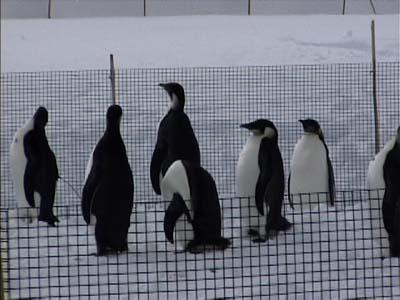23 January, 2001
The night before my departure to Antarctica while I was packing my father
reminded me of his only request: he would like a penguin. Actually, I had
several people ask for one of these formally dressed birds. In my fatherís
case, he had it all thought out. Living in northern Vermont on the shores
of Lake Champlain would be as perfect a places as anywhere to transplant a
penguin or two. Cold winters and lots of fish, thanks to the restocking
program instituted by the state. My father and the penguin should get
along well since they both like to ice fish.
There are eight species of penguins that occupy the Antarctic shores and
the subantarctic islands. The worldís largest is the emperor penguin
(Aptenodytes forsteri) which stands over 1 meter tall and can weigh up to
40kg. The emperor penguin is the only Antarctic bird that breeds in the
winter. A single egg is incubated on the feet of males. Think of the new
market for Nike.
After traveling 10,000 miles to where there are an estimated 200,000
breeding pairs of emperor penguins, the first penguins I was able get
close to ironically live in a pen. These juvenile emperor penguins were
chicks found abandoned in a rockery and are now temporarily residing at a
site called the Penguin Pool. Now five month old these penguins are about
a meter tall.
Here at the penguin pool, Dr. Timothy Welch and Dr. Torre Knower, are
studying the physiological changes that occurr in juvenile emperor
penguins as they make the transition from land to sea. While juveniles,
these young birds do not demonstrate the physical or physiological ability
to swim. Sometime around the fifth month, and almost overnight, the birds
take to the water. This transition coincides with a whole host of changes
which take place within the blood chemistry of the birds. The scientists
are taking blood samples of the juveniles in order to ìobserveî how this
process takes place.
The other study being conducted here is to place transmitters on the back
feathers of six of the penguins. The transmitters are not permanently
attached and will fall off with the next molt of the penguins feathers.
Not much is known about where the birds migrate to. The last time this
tracking experiment was tried the batteries inside the unit died just as
the birds were heading out of the Antarctic circle. This is the farthest
location that the migration has been recorded. This year the scientists are
back with new batteries, hoping for an answer to the migration question.

Juvenile Aptenodytes forsteri

Contact the TEA in the field at
.
If you cannot connect through your browser, copy the
TEA's e-mail address in the "To:" line of
your favorite e-mail package.
|
